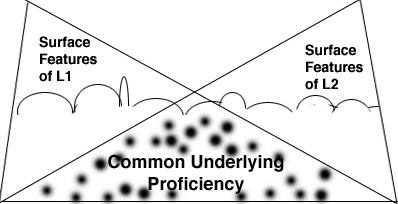
The Linguistic Interdependence Model

Based on Jim Cummins
Source: ASCD (1987). Building an Indivisible Nation: Binlingual Education In Context.
Certain factors that are part of proficiency in any language form an underlying core of factors or skills that can be used in any other language. The concept of common underlying proficiency (CUP) applies to both oral and written language and can best be understood in terms of reading. A student who has learned to read in his native language has many skills that will help him learn to read in English, even if that language is very different from English. He will already know that written text represents meaningful language, that symbols are used to convey language, that there are differences between how symbols are laid out that account for differences in meaning, that writing is read in a certain order and direction, and that there are different purposes for reading and writing. This common underlying proficiency carries over to English and does not need to be relearned although the particular features of English do need to be learned. In reading, it is particularly difficult to learn this underlying process in a language that is not understood by the reader. That is why many authorities recommend teaching reading to non-readers in the native language first and then switching over to English once the basics of reading have been understood.
**Reflect on a non-alphabetic language, such as Chinese. What CUP would a Chinese reader already have in his native language that could be transferred to English once learning to read in the new language? What are the particular features of English that the Chinese learner would need to learn in order to understand written English text? Please note that this is a self-reflection and does not need to be submitted to the facilitator.
|
|
||||||||
|
|
ESOL Home |
|
Module Home |
|
Back |
|
Next |
|
|
|
||||||||